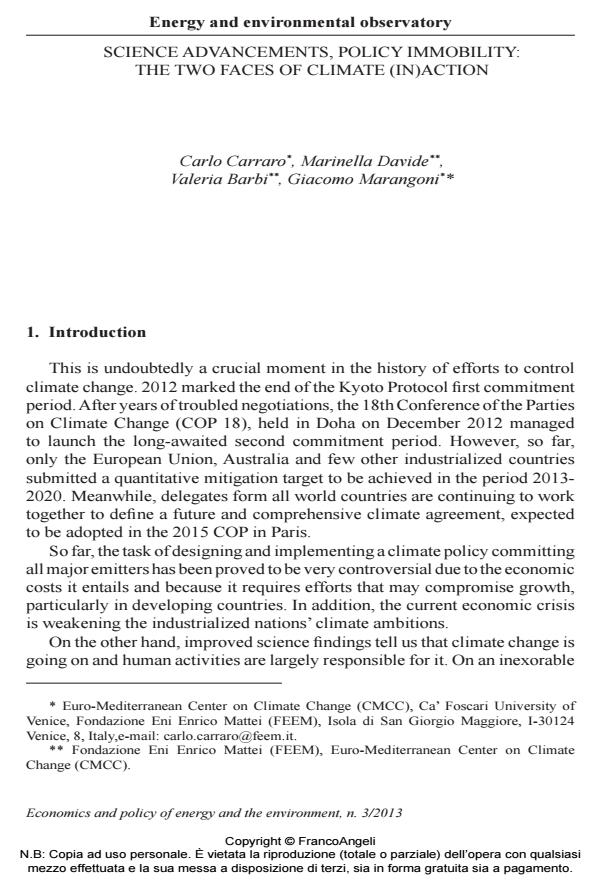Science adva ncements, policy immobility: the two fac es of climate (in)action
Titolo Rivista ECONOMICS AND POLICY OF ENERGY AND THE ENVIRONMENT
Autori/Curatori Carlo Carraro, Marinella Davide, Valeria Barbi, Giacomo Marangoni
Anno di pubblicazione 2014 Fascicolo 2013/3
Lingua Inglese Numero pagine 25 P. 5-29 Dimensione file 1214 KB
DOI 10.3280/EFE2013-003001
Il DOI è il codice a barre della proprietà intellettuale: per saperne di più
clicca qui
Qui sotto puoi vedere in anteprima la prima pagina di questo articolo.
Se questo articolo ti interessa, lo puoi acquistare (e scaricare in formato pdf) seguendo le facili indicazioni per acquistare il download credit. Acquista Download Credits per scaricare questo Articolo in formato PDF

FrancoAngeli è membro della Publishers International Linking Association, Inc (PILA)associazione indipendente e non profit per facilitare (attraverso i servizi tecnologici implementati da CrossRef.org) l’accesso degli studiosi ai contenuti digitali nelle pubblicazioni professionali e scientifiche
The first IPCC Assessment Report was released in 1990 and served as the scientific basis of the decisions taken within the United Nations Framework Convention on Climate Change (UNFCCC), signed in 1992. In 1997, the Convention adopted the Kyoto Protocol, which entered into force on 16 February 2005 as the first international agreement to reduce greenhouse gas from the atmosphere. The Kyoto Protocol assigned specific targets to industrialized nations, considered as the main responsible for the increase of carbon emissions, with the objective to reduce overall emissions by 5.2% compared to 1990 levels in the period 2008-2012. In the meanwhile, three other IPCC Assessment Reports were published in 1996, 2001 and 2007 and the next one, the fifth, is due by the end of 2014. In more than twenty years, the scientific community definitely made consistent progress in the understanding of climate change drivers and dynamics. On the contrary, the future of international climate policy still need to be defined. At the end of 2012, the first commitment period under the Kyoto Protocol just came to an end, leaving the world to cope with questions and uncertainties about the future of climate policy. Indeed, the second round of commitments under the Kyoto Protocol just started with few adhering countries, while the new international agreement including all Parties is expected to be adopted by 2015 and to come into force not before 2020. Ahead of the upcoming Warsaw UNFCCC Conference, it would be definitively worthwhile to take stock from the 2008 - 2012 Kyoto experience, also in the light of the efforts the international community is called to accomplish in the coming years. After a quick look at the key findings of the recently released Working Group I volume of the new IPCC Assessment Report, this paper analyses both the international and national dimensions of climate action, in order to understand how far countries are from reaching the emission reduction objectives that science believes to be necessary to avoid disruptive and irreversible climate change impacts. Through the WITCH model, the paper also provides some quantitative insights on the economic and energy implications of policies designed to limit temperature increase to no more than 2°C above pre-industrial levels.
Parole chiave:Climate Change Science, Greenhouse gas emission reduction, KyotoProtocol, International Climate Policy
Jel codes:F5, Q54, Q58
Carlo Carraro, Marinella Davide, Valeria Barbi, Giacomo Marangoni, Science adva ncements, policy immobility: the two fac es of climate (in)action in "ECONOMICS AND POLICY OF ENERGY AND THE ENVIRONMENT" 3/2013, pp 5-29, DOI: 10.3280/EFE2013-003001